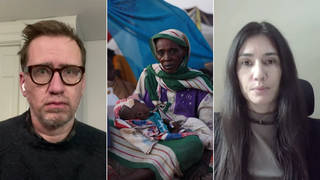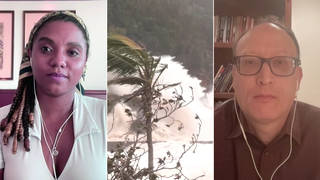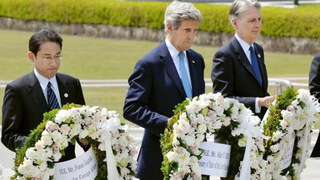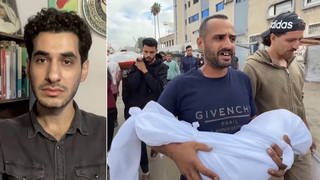
Topics
Guests
- Marylia Kelleyexecutive director of Tri-Valley CAREs, or Communities Against a Radioactive Environment. The organization and the Alliance for Nuclear Accountability recently published the report “Trillion Dollar Trainwreck,” which dissects the Obama administration’s plans to spend more than $1 trillion over the next 30 years on the U.S. nuclear weapons program.
Part 2 of our conversation with Marylia Kelley. Her group, the Alliance for Nuclear Accountability, just published a report titled “Trillion Dollar Trainwreck: Out-of-control U.S. nuclear weapons programs accelerate spending, proliferation, health and safety risks.”
Transcript
AMY GOODMAN: This is Democracy Now!, democracynow.org, The War and Peace Report. I’m Amy Goodman. On Monday, John Kerry became the first sitting secretary of state to visit Hiroshima, the Japanese city destroyed by a U.S. nuclear bomb on August 6, 1945. Three days later, the U.S. dropped a second atomic bomb on the city of Nagasaki. Hundreds of thousands of people were killed. The U.S. is the only country ever to drop an atomic bomb.
We’re turning now to Part 2 of our conversation with Marylia Kelley, the executive director of Tri-Valley CAREs, or Communities Against a Radioactive Environment, a partner organization with the Alliance for Nuclear Accountability, which just put out a new report called “Trillion Dollar Trainwreck: Out-of-control U.S. nuclear weapons programs accelerate spending, proliferation, health and safety risks.”
Welcome back to Democracy Now!, Marylia.
MARYLIA KELLEY: Thank you.
AMY GOODMAN: You live in Livermore?
MARYLIA KELLEY: I do, yes.
AMY GOODMAN: Can you talk about what Livermore is, this community in California?
MARYLIA KELLEY: Well, Livermore Lab is one of two places that designs every single nuclear weapon in the United States arsenal. So every nuclear weapon is designed either at Livermore Lab or at Los Alamos Lab in New Mexico. And when I first moved to Livermore in 1976, I only knew that everyone seemed to be employed at this secret lab, and slowly came to understand that they were developing nuclear weapons. Today, 86 percent of the lab’s budget is devoted to nuclear weapons activities. So, for listeners who think that perhaps nuclear weapons are a thing of the past, unfortunately they are not. They’ve left the 6:00 news—and thank God for Democracy Now!—but they have not left us. The United States has about 7,300 nuclear weapons. We’re in the process of designing and developing new ones and also new platforms and delivery vehicles—new bombers, new submarines, new missiles. And this, together, is the trillion-dollar trainwreck. It’s estimated to cost a trillion dollars, at least, over the next 30 years.
AMY GOODMAN: Why is the U.S. doing this? And why do you say they shouldn’t be?
MARYLIA KELLEY: The United States is doing this for a number of complicated reasons. One that’s little known, but I see it every day, is that the nuclear weapons labs, particularly Livermore Lab, are fighting to maintain their original mission as full-service nuclear weapon design laboratories. So there’s a lot of pressure to keep this enterprise going. And, of course, nowadays the labs are actually managed by firms like Bechtel, like Lockheed Martin, and there is also that corporate pressure to keep things going. So there’s money for the design of these weapons, and then the corporations get money to produce these weapons. And it’s actually the tail that’s wagging the dog of U.S. policy. And it’s moving us in a very dangerous direction.
AMY GOODMAN: What’s at stake?
MARYLIA KELLEY: There are two existential threats in the world that could change life as we know it. One is climate change, changing it long-term. The other is nuclear weapons. If they’re used in war, in an instant, life as we know it on this planet will change horribly.
AMY GOODMAN: How many countries have nuclear weapons? And how should the U.S. protect itself from countries, other countries, that have nuclear weapons?
MARYLIA KELLEY: So there are nine nuclear weapon states, including the undeclared nuclear weapon state of Israel. The United States has about 7,300 nuclear weapons. Russia has about the same number of operational nuclear weapons. Together, the U.S. and Russia have 93 percent of the world’s nuclear weapons. So, first step, the major nuclear weapon states need to unilaterally and bilaterally take concrete steps toward reducing the arsenals. And there’s U.S. policy about reducing reliance on nuclear weapons, but the design of new warheads and delivery vehicles with new military capabilities actually belies that. We’re not depending on them less; we’re moving in a direction of depending on them more and more and in more and more situations. And this is very dangerous.
AMY GOODMAN: So, what did President Obama say in Prague about a nuclear-free world?
MARYLIA KELLEY: Well, he talked about the United States’ obligation, as—and you mentioned—the only country to have dropped nuclear weapons in anger in war, to lead toward a world free of nuclear weapons. And I cheered. Many of us cheered. But we forget the next sentence. He said, as long as the United States has nuclear weapons, they’re going to be, you know, the most reliable, the most effective, etc. And that sentence is what the weapons labs are now driving new nuclear weapons through. So you get this circular reasoning, where—where we’re designing new military capabilities in the name of disarmament. Well, you cannot get to disarmament by designing new nuclear weapons. And recently, Russia is mirroring, and they’re starting to spend billions of dollars upgrading their arsenal. China, which has a much smaller arsenal, is actually talking now about specific upgrades. And all of the other small nuclear weapon states are following this path. So we’re on the precipice of a new arms race, not exactly like the old one with the Soviet Union, because it’s not going to be about huge numbers and throw rates—throw weights, sorry, but a new kind of a nuclear arms race that’s about capabilities, about precision guidance, about dial-a-yield options down to very low yields to make them militarily usable in conflict. These things may actually—and I believe they are—be more dangerous than the arms race that was on the 6:00 news all during the ’50s and the ’60s.
AMY GOODMAN: Can you talk about the U.S. designing smaller nuclear weapons? I want to turn to a quote of General James Cartwright, retired vice chair of the Joint Chiefs of Staff, who told The New York Times, “what going smaller does is to make the weapon more thinkable.”
MARYLIA KELLEY: Yes.
AMY GOODMAN: Your thoughts about this, Marylia Kelley?
MARYLIA KELLEY: This is extraordinarily dangerous. When I talk about adding new dial-a-yield options, that’s what I’m talking about, where you can actually—and they’re dials—you can actually change what the yield will be in the field before it’s used, so that it will now be militarily thinkable, militarily usable in conflict. This is a—we’ve had dial-a-yield, but these new precision guidance—the new precision guidance that’s going into nuclear weapons, so that a nuclear weapon will now be very precise, so that you can get extraordinary damage at low yields, these are all making them more thinkable, in General Cartwright’s words, more usable, in the words that I use.
AMY GOODMAN: Going back to you living in Livermore—
MARYLIA KELLEY: Yes.
AMY GOODMAN: —what’s happening there? And can you talk about your concerns about the nuclear development there?
MARYLIA KELLEY: Absolutely. Right now, Livermore Lab is the lead laboratory to develop a new warhead for a new cruise missile, this Long-Range Standoff weapon of which I spoke. They also have hopes in the year 2020 to begin development of a new interoperable warhead to be launched more or less interchangeably between subs and land-based silos. This would be a mashup of various nuclear weapons designs, all of this, again, being extraordinarily dangerous. It is also extraordinarily toxic. Livermore Lab is a Superfund cleanup site, meaning it’s on the EPA’s list of most contaminated locations in the country. I recently moved, but under my old home was an offsite groundwater plume emanating from the lab with toxic waste in it. There’s leaking—leaching down through the soil into the aquifer a number of toxic and radioactive materials that come from the nuclear weapons work. They found elevated levels of plutonium in Big Trees Park near where I lived. There have—there’s real danger. And there have been major, major accidents. Two of the three biggest accidents in the country with radioactive hydrogen, which is called tritium, happened at Livermore Lab, airborne releases of this radioactive hydrogen. Also, there have been airborne releases of uranium, of plutonium, etc.
AMY GOODMAN: Well, here you have a situation where the scientists live in this community, this endangered community.
MARYLIA KELLEY: Yes.
AMY GOODMAN: And perhaps there’s no one more than the scientists who understand the dangers of the environment they’re in. Are you finding allies within Livermore?
MARYLIA KELLEY: Tri-Valley CAREs was founded in 1983. And we—one of our founding handful of folks, one of our founding six, was a laboratory scientist. We now have 5,600 members, and so there are hundreds of lab scientists and engineers and technicians among our membership. Some go into denial. Others really want to do something to make the environment better. Some want to actually change the lab’s mission to a civilian science mission. For us, the issue isn’t should our country have scientists; the issue is what should they be paid to do. We’re very pro-science. We want to see the small, tiny part of the lab where they do actual civilian science grow and become the center of the lab.
AMY GOODMAN: What are Life Extension Programs?
MARYLIA KELLEY: Life Extension Programs, sometimes I joke—explain them this way: The United States actually has universal, single-payer healthcare. It’s just not for people. It’s for our nuclear weapons. But through the Life Extension Programs, they’re actually going beyond extending the service life of these horrible nuclear warheads, and they’re putting in the new capabilities of which we spoke. So, through Life Extension Programs, they’re actually upgrading the arsenal and putting in new military capabilities. That’s why this program is so expensive. If you look—and we have a graph that shows this—if you look at the arsenal since the year 2000, and you can see that it has gone down sharply since the year 2000, but the costs have gone up. So now we’re actually spending twice as much money maintaining half as many nuclear weapons. And it’s not because they’re aging. It is not because they’re aging in an ungraceful way. The simple maintenance of nuclear weapons would not cost this much. It’s the new capabilities that are being designed into the weapons. And the other countries see this, and that—and then follow suit.
AMY GOODMAN: So, right now, your report is called “Trillion Dollar Trainwreck.”
MARYLIA KELLEY: Yes.
AMY GOODMAN: And you’re looking at out-of-control U.S. nuclear weapons programs accelerating spending, proliferation, health and safety risks.
MARYLIA KELLEY: Yes.
AMY GOODMAN: There are many NGOs, nongovernmental organizations, nonprofits, that are hoping that not only John Kerry will go to Hiroshima, as he did this week—
MARYLIA KELLEY: Mm-hmm, mm-hmm.
AMY GOODMAN: —but that President Obama will.
MARYLIA KELLEY: Yes.
AMY GOODMAN: Why?
MARYLIA KELLEY: We are hoping that President Obama goes. We are recommending that he not go empty-handed, however. I think that there are—there are two levels. One is the level of symbolism, and symbolism does matter. I think it will matter that the U.S. president goes to Hiroshima. But if he goes empty-handed, then it’s a photo op. We want him to go with substantive announcement. And in particular, we are pressing the president to announce the cancellation of this new Long-Range Standoff weapon, the new nuclear-tipped cruise missile. And eight senators sent him a letter, including both of our California senators, Dianne Feinstein and Barbara Boxer, urging President Obama not to put any money in the fiscal year 2017 budget request for this destabilizing new weapon. And he did. He put in money, $220 million, for Livermore Lab to design the warhead, more money in the Defense Department budget to actually design the cruise missile. And he could retract that. He could say that we’re going to put that on hold or cancel it outright. So I think it’s important in terms of the optics of the president going, but I think it’s even more important that he go with something concrete to say.
AMY GOODMAN: What about apologizing for the dropping of the atomic bombs on Hiroshima and Nagasaki, the hundreds of thousands of people who died?
MARYLIA KELLEY: Mm-hmm, yes. I think it’s appropriate to apologize. But as a parent, when my child apologized for some just, you know, childhood discretion, I then asked him how he’s going to make it right. So I would ask the president the same thing. Yes, apologize, but what are you going to do, Mr. President, to change the new nuclear arms race to make sure that a nuclear weapon is never, ever again dropped in anger?
AMY GOODMAN: You talk about leaving radioactive waste where it is. What are the communities of the United States that house nuclear waste? And what should be done about it?
MARYLIA KELLEY: Nuclear waste is a very, very difficult issue. So, step one is start—step one is stop producing it. Once you produce a nuclear waste, you have to sort of choose the best of the bad options. And there was a very politically driven program to dump a high level—this is the irradiated nuclear fuel rods—in Yucca Mountain in Nevada, which we opposed. Right now, the Department of Energy is going through what it calls a consent-based process to try to find communities that will “consent” to becoming either interim storage or disposal sites. But the Department of Energy—
AMY GOODMAN: And do they consent because they’re poor? What do they get for this?
MARYLIA KELLEY: Well, this is what we’re discussing: What does consent mean? Informed consent means they understand the risks. How do they—how does a community consent for future generations that are unborn? I’ll give you one example. Plutonium-239 has a—which is weapons-grade plutonium—has a half-life of 24,400 years. A hazardous life is roughly 10 half-lives, 240,000 years. How do you truly consent for 240,000 years? So, why—and is the agency that’s in charge of our nuclear weapons program the right agency to go out and talk about consent? DOE has shown that it doesn’t understand consent. DOE’s modus operandi, we call it DAD—decide, announce, defend. They don’t understand consent. An independent agency needs to be taking a look at this. And in the meantime, where it’s safe, the nuclear waste should stay in place. And we are recommending that it be put in hardened on-site storage, so that it is not vulnerable where it presently sits. And ultimately, something will need to be done. But if the Department of Energy prevails on a particular community to “consent” to having an interim storage site, I predict that the first hole in the ground they get will be where the waste stays for a very, very long time. And so, we just—we need a process that is much, much better. And we need to understand that communities are and will be sacrificing because we have produced these wastes. And for the future, we at least owe it to our children and our grandchildren and their children and grandchildren for the next couple hundred thousand years not to continue producing these wastes.
AMY GOODMAN: Marylia Kelley, explain who the nuclear lobby is.
MARYLIA KELLEY: It’s—
AMY GOODMAN: What are the corporations? What—how much money are they making?
MARYLIA KELLEY: It’s vast. So, in terms of nuclear weapons, the University of California is one of the biggest entities managing—they’ve managed the bomb since the Manhattan Project. They are partners in the management of both Livermore Lab and Los Alamos Lab. So you have University of California near the top of the list. You’ve got Lockheed Martin. You’ve got Bechtel, which is co-managing Livermore Lab with the University of California. You’ve got all of the big defense contractors. If they’re not managing the bomb, they are producing the weapons. And many of them are doing both. So they tell Congress they need to design something, and then they get money again to produce it. So it is a huge, huge problem that involves corporations, and it actually involves the increasing militarization that we’re seeing of universities.
AMY GOODMAN: I wanted to get your assessment of the presidential candidates and their proposals on nuclear weapons and America’s nuclear arsenal. Let’s see, you have Sanders co-sponsoring Ed Markey’s SANE Act—
MARYLIA KELLEY: Yes.
AMY GOODMAN: —which would save up to $100 billion over 10 years from President Obama’s nuclear weapons plan, but would also preserve a U.S. arsenal of how many warheads, 1,500 or so?
MARYLIA KELLEY: Well, those are the long-range operationally deployed, what are called the strategic warheads. The arsenal is actually bigger than that. But the SANE Act would at least stem some of the flow of money into new bombs and warheads. So we were very supportive of that and actually worked with Ed Markey’s office on some of the technical questions.
AMY GOODMAN: What is Hillary Clinton’s position?
MARYLIA KELLEY: In terms of the trillion-dollar trainwreck, the trillion dollars that we are planning to spend over the next 30 years, she has at least said, quote-unquote, that she “would take a look at it, if elected.”
AMY GOODMAN: In December, Hillary Clinton said, quote, “What I said and what I mean is that there will have to be consequences for any violation by Iran and that the nuclear option should not at all be taken off the table. That has been my position consistently.” She later corrected herself, saying she meant to say “military option.”
MARYLIA KELLEY: It is U.S. policy to be ambiguous about the circumstances under which the U.S. would use a nuclear weapon, including the possible first use of a nuclear weapon. The United States does not have a clear and unambiguous no-first-use policy. That would be a step in the right direction. Our policy is deliberately ambiguous. And Iran does not have nuclear weapons. I always try to emphasize that. We’re talking about preventing the acquisition of a nuclear weapon, which I think no one should have nuclear weapons, so of course I support that. But we can’t just talk about Iran and its nuclear weapons-related program—let me call it that. We need to talk about the U.S. arsenal. What about the 7,300 that we have?
AMY GOODMAN: And what about Donald Trump raising the possibility Japan should arm itself with nuclear weapons to deter a threat from North Korea?
MARYLIA KELLEY: Donald Trump has been every single possible place on the map on this issue depending on—and sometimes in the same speech. Oddly, when he talks about the U.S. potentially using a nuclear weapon first, he is actually stating U.S. policy, which usually remains unstated.
AMY GOODMAN: Which is?
MARYLIA KELLEY: Which is that there are circumstances where we’re ambiguous about it, and we might use a nuclear weapon first. We’ve not ruled this out as our policy. In terms of Japan should look at getting nuclear weapons, no country—no country should acquire nuclear weapons. Those that have nuclear weapons are obligated legally to disarm, under—under international law, what’s called customary international law, and the Non-Proliferation Treaty.
And an exciting development that I didn’t talk about before is that the tiny, courageous republic of the Marshall Islands has taken all of the nuclear weapon states to court at the International Court of Justice. And the Marshall Island was bombed by—you know, in U.S. hydrogen bomb testing. But they’re not going to the International Court of Justice in this case for compensation for their own horrible, horrible health injuries. They’re going to try to compel the disarmament that is required.
AMY GOODMAN: Marylia Kelley is executive director of Tri-Valley CAREs, or Communities Against a Radioactive Environment, a partner organization with the Alliance for Nuclear Accountability.












Media Options